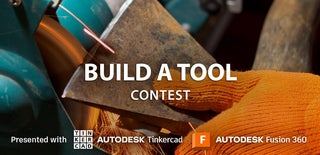Introduction: DIY Drag Knife Cutter...
Yep, It's a drag knife cutter tool made out of scraps....
I wanted to level up a writing machine that I had previously built out of printer parts.
So I made this project to see whether a misfit writing machine could be transformed into a CNC Drag Knife Cutter.
It isn't perfect, but it will get the job done.
I have used the fusion 360 software to generate the G- code for the cutting operation.
The procedure for generating the g-codes is also included in this project.
Don't forget to watch the attached video....
Tag along for more amazing projects...
Supplies
Materials used :
- 25 mm PVC pipe
- One 608RS Ball bearing
- Cutter knife blades
- 8mm nut and bolt
- M-seal epoxy
- Small nut and bolt [Salvaged from a VGA connector]
Tools used :
- Hacksaw
- Screwdrivers
- Pliers
Step 1: Fixing the Bearing...
We will begin our project by fixing the ball bearing onto the 25 mm PVC pipe [Slightly heat the PVC pipe to make it a bit pliable for easy installation ].The length of the pipe should be in the range of 4 to 6 cm.
Step 2: Hacksawing...
The 8mm nut and bolt are fastened, and the part is cut with the help of a hacksaw as shown in the picture.
Step 3: Epoxying ...
Using m-seal epoxy, the nut [from the VGA connector] is glued in its place.
With this, our drag knife cutter is complete. Now we only need to fasten a cutter blade onto it with the help of screws and finally attach it to a CNC machine.
Step 4: Results....
Despite the fact that my CNC machine is a bit shaky, the cut outs turned out fairly well.
You guys can check out the attached video to see the cutting process in action.
Step 5: Fusion 360 - New Project....
We will start by creating a new project. After that select the XY plane and sketch the required pattern / letter.
Don't forget to specify the size of the sketch created. Extrude it to the same thickness as the paper that will be used to cut out the design.
Step 6: To the Manufacturing Workspace...
After completing the part modeling, go to the manufacturing section. First of all, we need to define the specifications of the stock[ from the setup tab] like offset distances, orientations, references, etc..
After defining the stock, go to the 2D contouring operation. Using this operation, we will define the contours to cut, the depth of cut, etc. But first, we have to make a unique tool. For that, move on to the next step.
Watch the video attached [in the intro] for a much better understanding.
Step 7: Creating a Custom Tool...
Since we don't have a drag knife tool in fusion, we need to create one for our needs.
For this, we will be modifying an end flat mill tool. Firstly, we will start by giving it a name and then change its diameter to 1 mm, shaft diameter to 1 mm, number of flutes to 1,etc. The length of the tool can be given according to your CNC machine, but since mine had only a small head room, I had to go with these small values as indicated in the pictures. We also need to change the cutting feed rate to 200 mm/min.
After modifying everything, click accept. Viola! Our custom tool is ready for action.
Step 8: Selecting the Contours...
Simply select contour one at a time in the desired cutting sequence to determine the contours to be cut. Don't forget to click on the preserve order box. Then, set the heights for the feed, retract, and clearance. In order to properly position the blade at the start of the cut, we need to define the entry point. With this, we have finished the cutting process. All that is left to do is export the G-code.
Step 9: Exporting and Sending...
Simply choose the post processor option under the "actions" tab to output the G codes for the cutting operation.
You'll see a dialog box. Now choose the Grbl/grbl option from the library in the post section. Specify the output folder location and give your file a name. Additionally, be sure to include the safe retract; otherwise, your blade will drag over the cutting surface during the beginning of the cut.
Once everything has been specified, click "post" to export it.
The prepared G-code was then sent to my CNC machine using the UGS software.
I hope you guys enjoyed reading my misfit instructable...
Thank you....

Participated in the
Build a Tool Contest













